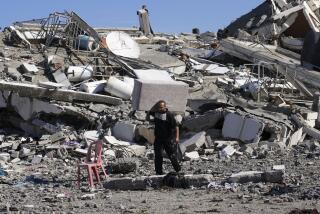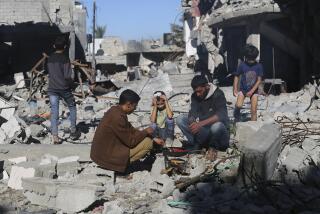Scattered Shelling Mars Latest Yugoslav Cease-Fire
ZAGREB, Croatia — Sporadic shelling echoed around the strategic city of Osijek on Monday, but the 14th cease-fire in Yugoslavia’s civil war reportedly held elsewhere in Croatia.
There were growing signs that Serbia and Croatia were trying to extricate themselves from the increasingly brutal war, which began after Croatia’s June 25 declaration of independence.
Some federal troops began withdrawing from army garrisons in Croatia after the republic’s government agreed to lift a blockade on the bases, and Croatian and federal military leaders reached an agreement in Zagreb for an exchange of all prisoners, the state news agency Tanjug reported.
The agreement is to be signed today. In a preliminary gesture, Milan Aksentijevic, a federal army general captured by the Croats, was exchanged for Antun Kikas, a Canadian businessman of Croat origin who was arrested by the army for allegedly trying to smuggle arms into Croatia.
Still, with the failure of 13 previous cease-fires in mind, officials here were not predicting a quick peace. Some believed that heavy rain and snowfall in parts of Croatia may have played a role in halting the fighting Monday.
The truce in Croatia, the first brokered by the United Nations, is supposed to pave the way for deployment of U.N. peacekeeping forces to separate warring Serbs and Croats and halt the war.
But Croats fear the Serb-dominated army and Serbian irregulars will first try to capture Osijek, the largest city in eastern Croatia, to seal their control over the region.
Serbia would then presumably allow what remains of Croatia to secede from the Yugoslav federation, while keeping part of the territory for Croatia’s 600,000 ethnic Serbs. Croatia refuses to surrender any of its lands.
In the fighting, however, Croatia already has lost about a third of its territory. It suffered a major defeat Nov. 16 when the army captured Vukovar, 20 miles southeast of Osijek, after a three-month battle.
Slavko Dokmanovic, president of Vukovar’s City Council, said Monday that about 5,000 people died in the fight for his town, the news agency Tanjug reported.
On Monday, three bodies and 15 wounded people were brought to the Osijek hospital after morning shelling by Serbian forces, a hospital official said by telephone.
The attacks faded to sporadic bursts in the afternoon. About a third of Osijek’s 140,000 inhabitants remain. Thousands have fled across the nearby border with Hungary.
More to Read
Sign up for Essential California
The most important California stories and recommendations in your inbox every morning.
You may occasionally receive promotional content from the Los Angeles Times.










